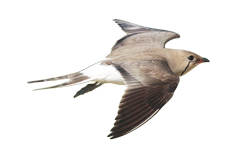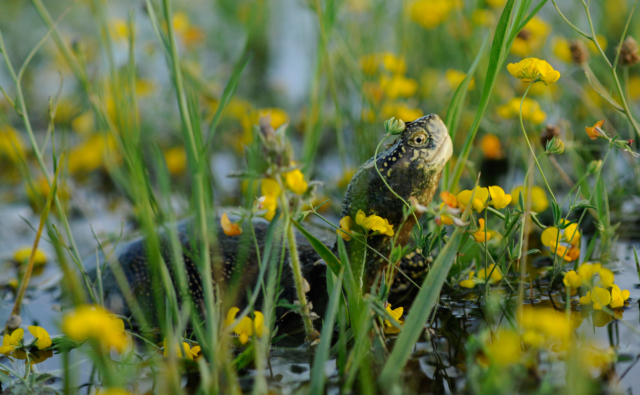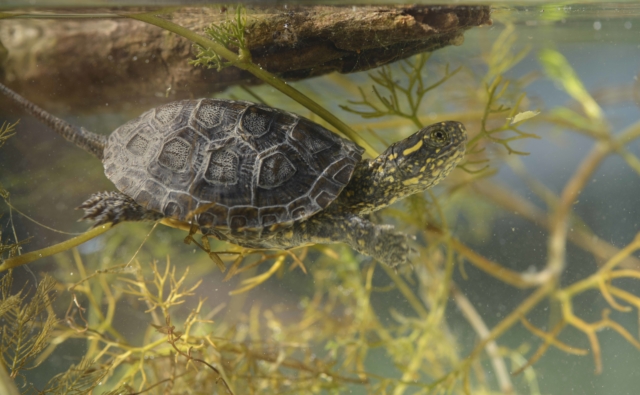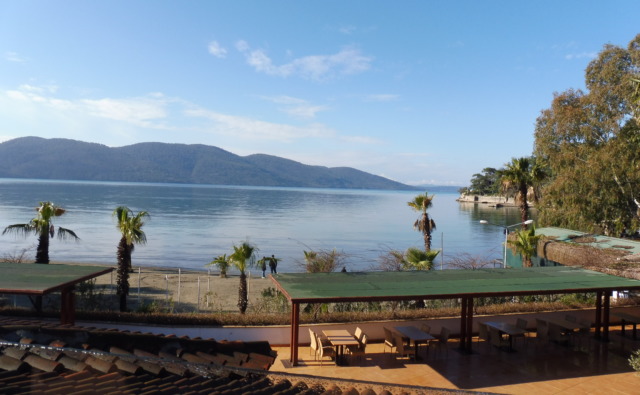Population dynamics of European Eel in the Vaccarès lagoon hydrosystem
Objectives
The European Eel (Anguilla anguilla) is a migratory fish whose populations have fallen dramatically since the 1980s throughout its range. Since 2007, the species has been listed in Appendix II of the CITES Convention, and since 2008 in the International Union for the Conservation of Nature’s Red List of “Critically Endangered” species. In compliance with European Union regulations, a National Management Plan (NPM) for the Eel has been established. In this framework, the hydrosystem of the Etang du Vaccarès in the Camargue was selected as an index lagoon for monitoring the status of the European Eel population, because Mediterranean lagoons are well known for their high-level production of silver eels. The Eel NPM and the Rhone-Mediterranean migratory fish management plan (PLAGEPOMI) set the monitoring objectives for the recruitment (arrival of glass eels) and the downstream migration (return of the silver eels back to the sea).
Actions and methodology
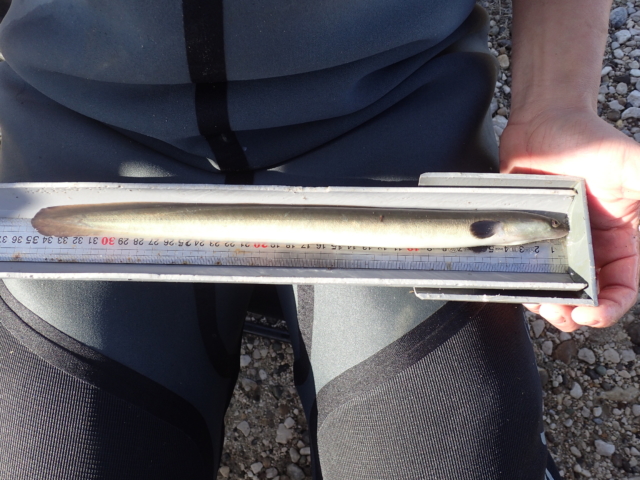
The Tour du Valat set up a monitoring programme in 1993 for all life stages of the European Eel at various stations in the Vaccarès lagoon system. This monitoring has already characterised the eels’ life traits associated with the Vaccarès system (growth, production, male/female proportion, and parasitism). A demographic model was developed using these data to estimate the escapement rate of various systems in function of different management scenarios (for more information).
An experimental restocking of eels was carried out in the Camargue between 2007 and 2015, in collaboration with Migrateurs Rhôné Méditerranée (MRM) and the Friends of the Vigueirat Marshes, in order to test the efficacy of the model, i.e. the quantity and quality of the silver eels produced. Some of the results have been presented in the form of a leaflet.
Recruitment has been monitored since 1993 using fine-mesh (1.5 mm) capéchade trap nets at the Capelière in partnership with the Société National de la Protection de la Nature / Camargue National Reserve. A glass-eel fishway trap has been installed since 2004 at the Pertuis de la Fourcade, the main connection between the Vaccarès system and the sea. The trap is managed by the MRM association. Recruitment via the Rhone water pumping system during the rice-growing period was monitored at the station of Le Sambuc between 1997 and 2001, and was resumed by MRM in 2018.
Between October 2016 and May 2021, the recruitment and downstream migration of the European Eel have also been monitored in the Camargue Saltworks Lagoons and Marshes (CSLM). Since it was acquired in 2011 by the Conservatoire du littoral (national coastal protection agency), the hydrobiological continuity of the site between the sea and the Etang du Vaccarès lagoon has been restored (for more information). This territory provides a new migration route to the East of the Camargue delta, outside the summer periods during which the lagoons are partly dried up or hypersaline.
From 2020 to 2021, a meta-analysis of all existing data was carried out in order to characterize the dynamics of glass eel recruitment at different entry points of the delta. This study also took into account the data from the fishway traps located at the Canal d’Arles à Fos, one at its mouth and managed by the Grand Port Maritime de Marseille and the other more inland and managed by the Friends of the Vigueirat marshes. Using Bayesian models, temporal (year, month) and spatial (inter-site) variations in glass eel recruitment were analyzed and the influences of environmental factors were tested for a better understanding of the temporal dynamics of glass eel migration in the delta.
Since 2001, the European eel has been monitored by capture-mark-recapture (CMR) on a portion of the main drainage channel of a catchment area of the Étang de Vaccarès, the Fumemorte basin. This canal crosses the Tour du Valat regional reserve. CMR data allow the development of population dynamics models that are of great interest in conservation biology, in particular to monitor the status of a wild population (or in the case of the eel, a fraction of a population), to study its demographic parameters and its dispersion dynamics.
Since 2019, telemetric monitoring by radio-frequency identification has been set up in the Fumemorte canal to reinforce the monitoring of longitudinal movements of marked individuals and thus better characterize the migratory dynamics of eels in the yellow and silver stages between the Vaccarès pond and one of its drainage basins.
Results
The thematic information brochure on the European Eel in the series Sciences & Management (in French) presents all the work undertaken by the Tour du Valat between 1993 and 2013.
Below is a video presentation of the COLAGANG project: Study of Intra-Lagoon Ecological Connectivity: Monitoring the movements of European Eels produced by two watersheds of the Vaccarès pond.
Team
- Project leader: Delphine Nicolas
- Staff involved: Pascal Contournet
- Date of project: Since 1993
Partners
Technical partners
- Friends of the Vigueirat Marshes Association
- Association MRM (Migrateurs Rhône Méditerranée)
- Société Nationale de Protection de la Nature / Camargue National Reserve
- Institute of Research for Development (IRD)
- National Centre for Scientific Research (CNRS)
- National Natural History Museum (MNHN)
- Paul Sabatier University, Toulouse III
Financial partners
- Rhone-Mediterranean and Corsica Water Agency
- Provence-Alpes-Côte d’Azur Region
- Bouches-du-Rhône Departmental Council
Publications
- Acou, A., Boury, P., Laffaille, P., Crivelli, A.J. and Feunteun, E. (2005) Towards a standardized characterization of the potentially migrating silver European eel (Anguilla anguilla, L.). Archiv fur Hydrobiologie 164, 237–255.
- Acou, A., Lefebvre, F., Contournet, P., Poizat, G., Panfili, J. and Crivelli, A.J. (2003) Silvering of female eels (Anguilla anguilla) in two sub-populations of the Rhône delta. Bulletin Français de la Pêche et de la Pisciculture, 55–68.
- Acou, A., Poizat, G. and Crivelli, A.-J. (2006) Errors in ocular index measurements in European eel Anguilla anguilla (L.). Ecology of Freshwater Fish 15, 578–582.
- Bevacqua, D., Andrello, M., Melià, P., Vincenzi, S., De Leo, G.A. and Crivelli, A.J. (2011) Density-dependent and inter-specific interactions affecting European eel settlement in freshwater habitats. Hydrobiologia 671, 259–265.
- Bevacqua, D., Melia, P., Crivelli, A.J., De Leo, G.A. and Gatto, M. (2006) Timing and rate of sexual maturation of European eel in brackish and freshwater environments. Journal of Fish Biology 69, 200–208.
- Bevacqua, D., Melia, P., Crivelli, A.J., Gatto, M. and De Leo, G.A. (2007) Multi-objective assessment of conservation measures for the European eel (Anguilla anguilla): an application to the Camargue lagoons. ICES Journal of Marine Science 64, 1483–1490.
- Boulenger, C., Crivelli, A.J., Charrier, F., Roussel, J.-M., Feunteun, E. and Acou, A. (2016) Difference in factors explaining growth rate variability in European eel subpopulations: the possible role of habitat carrying capacity. Ecology of Freshwater Fish 25, 281–294.
- Crivelli, A.J., Auphan, N., Chauvelon, P., Sandoz, A., Menella, J.-Y. and Poizat, G. (2008) Glass eel recruitment, Anguilla anguilla (L.), in a Mediterranean lagoon assessed by a glass eel trap: factors explaining the catches. Hydrobiologia 602, 79–86.
- Crivelli, A.J. and Hermeloup, C. (2013) L’anguille européenne, Sciences et gestion.
- Desprez, M., Crivelli, A.J., Lebel, I., Massez, G. and Gimenez, O. (2013) Demographic assessment of a stocking experiment in European Eels. Ecology of Freshwater Fish 22, 412–420.
- Lefebvre, F., Acou, A., Poizat, G. and Crivelli, A.J. Anguillicolosis among silver eels: A 2-year survey in 4 habitats from Camargue (Rhone Delta, South of France). Bulletin Français de la Pêche et de la Pisciculture, 97–108.
- Lefebvre, F., Contournet, P. and Crivelli, A.J. (2002a) The health state of the eel swimbladder as a measure of parasite pressure by Anguillicola crassus. Parasitology 124, 457–463.
- Lefebvre, F., Contournet, P., Priour, F., Soulas, O. and Crivelli, A.J. (2002b) Spatial and temporal variation in Anguillicola crassus counts: results of a 4 year survey of eels in Mediterranean lagoons. Diseases of Aquatic Organisms 50, 181–188.
- Lefebvre, F. and Crivelli, A. (2012) Salinity effects on anguillicolosis in Atlantic eels: a natural tool for disease control. Marine Ecology Progress Series 471, 193–202.
- Lefebvre, F., Fazio, G., Mounaix, B. and Crivelli, A.J. (2013) Is the continental life of the European eel Anguilla anguilla affected by the parasitic invader Anguillicoloides crassus? Proceedings. Biological Sciences 280, 20122916.
- Lefebvre, F., Fazio, G., Palstra, A.P., Székely, C. and Crivelli, A.J. (2011) An evaluation of indices of gross pathology associated with the nematode Anguillicoloides crassus in eels. Journal of Fish Diseases 34, 31–45.
- Lefebvre, F., Mounaix, B., Poizat, G. and Crivelli, A.J. (2004) Impacts of the swimbladder nematode Anguillicola crassus on Anguilla anguilla: variations in liver and spleen masses. Journal of Fish Biology 64, 435–447.
- Lefebvre, F., Sergent, E., Acou, A., Lecomte-Finiger, R. and Crivelli, A.J. Recrutement des civelles (Anguilla anguilla) sur la côte méditerranéenne française : analyse comparée des caractéristiques biométriques et pigmentaires des saisons 1974-75 et 2000-01. Bulletin Français de la Pêche et de la Pisciculture, 85–96.
- Lefebvre, F.S. and Crivelli, A.J. (2004) Anguillicolosis: dynamics of the infection over two decades. Diseases of Aquatic Organisms.
- Maes, G.E., van Vo, B., Crivelli, A.J. and Volckaert, F. a. M. (2009) Morphological and genetic seasonal dynamics of European eel Anguilla anguilla recruitment in southern France. Journal of Fish Biology 74, 2047–2068.
- Melià, P., Bevacqua, D., Crivelli, A.J., De Leo, G.A., Panfili, J. and Gatto, M. (2006a) Age and growth of Anguilla anguilla in the Camargue lagoons. Journal of Fish Biology 68, 876–890.
- Melià, P., Bevacqua, D., Crivelli, A.J., Panfili, J., De Leo, G.A. and Gatto, M. (2006b) Sex differentiation of the European eel in brackish and freshwater environments: A comparative analysis. Journal of Fish Biology 69, 1228–1235.
- Melia, P., Crivelli, A.J., Durif, C., Poole, R. and Bevacqua, D. (2014) A simplified method to estimate body growth parameters of the European eel Anguilla anguilla. Journal of Fish Biology 85, 978–984.
- Panfili, Jacques, Ximénès, Marie-Claude and Crivelli, A. J. (1994) Sources of variation in growth of the European eel (Anguilla anguilla) estimated from otoliths. Canadian Journal of Fisheries and Aquatic Sciences 51, 506–515.
- Panfili, J., Darnaude, A., Lin, Y., Chevalley, M., Iizuka, Y., Tzeng, W. and Crivelli, A. (2012) Habitat residence during continental life of the European eel Anguilla anguilla investigated using linear discriminant analysis applied to otolith Sr:Ca ratios. Aquatic Biology 15, 175–185.
- Schiavina, M., Bevacqua, D., Melià, P., Crivelli, A.J., Gatto, M. and De Leo, G.A. (2015) A user-friendly tool to assess management plans for European eel fishery and conservation. Environmental Modelling & Software 64, 9–17.
